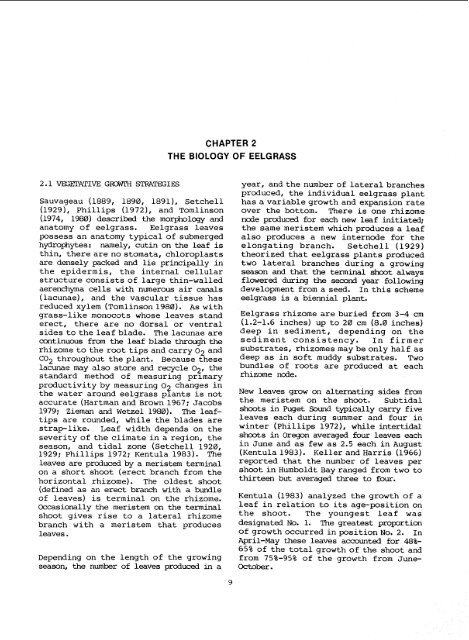The ecology of eelgrass meadows in the Pacific Northwest: A ...
The ecology of eelgrass meadows in the Pacific Northwest: A ...
The ecology of eelgrass meadows in the Pacific Northwest: A ...
- No tags were found...
Create successful ePaper yourself
Turn your PDF publications into a flip-book with our unique Google optimized e-Paper software.
CHAPTER 2<br />
THE BIOLOGY OF EELGRASS<br />
2.1 VEGETATIVE GlXWlTd STRATEGIES<br />
Sauvageau (1889, 1890, 1891), Setchell<br />
(19291, Phillips (1972), and Toml<strong>in</strong>son<br />
(1974, 1980) described <strong>the</strong> morphology and<br />
anatomy <strong>of</strong> <strong>eelgrass</strong>. Eelgrass leaves<br />
possess an anatomy typical <strong>of</strong> submerged<br />
hydrophytes: namely, cut<strong>in</strong> on <strong>the</strong> leaf is<br />
th<strong>in</strong>, <strong>the</strong>re are no stomata, chloroplasts<br />
are densely packed and lie pr<strong>in</strong>cipally <strong>in</strong><br />
<strong>the</strong> epidermis, <strong>the</strong> <strong>in</strong>ternal cellular<br />
structure consists <strong>of</strong> large th<strong>in</strong>-walled<br />
aerenchyma cells with numerous air canals<br />
(lacunae), and <strong>the</strong> vascular tissue has<br />
reduced xylem (Toml<strong>in</strong>son 1980). As with<br />
grass-like monocots whose leaves stand<br />
erect, <strong>the</strong>re are no dorsal or ventral<br />
sides to <strong>the</strong> leaf blade. <strong>The</strong> lacunae are<br />
cont<strong>in</strong>uous from <strong>the</strong> leaf blade through <strong>the</strong><br />
rhizome to <strong>the</strong> root tips and carry o2 and<br />
C02 throughout <strong>the</strong> plant. Because <strong>the</strong>se<br />
lacunae may also store and recycle 02, <strong>the</strong><br />
standard method <strong>of</strong> measur<strong>in</strong>g prlmary<br />
productivity by measur<strong>in</strong>g O2 changes <strong>in</strong><br />
<strong>the</strong> water around <strong>eelgrass</strong> plants is not<br />
accurate (Hartmanand Brown1967; Jacobs<br />
1979; Zieman and Wetzel 1980). <strong>The</strong> leaftips<br />
are rounded, while <strong>the</strong> blades are<br />
straplike. Leaf width depends on <strong>the</strong><br />
severity <strong>of</strong> <strong>the</strong> climate <strong>in</strong> a region, <strong>the</strong><br />
season, and tidal zone (Setchell 1920,<br />
1929; Phillips 1972; Kentula 1983). <strong>The</strong><br />
leaves are produced by a meristem term<strong>in</strong>al<br />
on a short shoot (erect branch from <strong>the</strong><br />
horizontal rhizome). <strong>The</strong> oldest shoot<br />
(def<strong>in</strong>ed as an erect branch with a bundle<br />
<strong>of</strong> leaves) is term<strong>in</strong>al on <strong>the</strong> rhizome.<br />
Occasionally <strong>the</strong> meristem on <strong>the</strong> term<strong>in</strong>al<br />
shoot gives rise to a lateral rhizome<br />
branch with a meristem that produces<br />
leaves.<br />
Depend<strong>in</strong>g on <strong>the</strong> length <strong>of</strong> <strong>the</strong> grow<strong>in</strong>g<br />
season, <strong>the</strong> number <strong>of</strong> leaves produced <strong>in</strong> a<br />
year, and<strong>the</strong> number <strong>of</strong> lateral branches<br />
produced, <strong>the</strong> <strong>in</strong>dividual <strong>eelgrass</strong> plant<br />
has a variable growth and expansion rate<br />
over <strong>the</strong> bottom. <strong>The</strong>re is one rhizome<br />
ncde prcduced for each new leaf <strong>in</strong>itiated;<br />
<strong>the</strong> same meristem which produces a leaf<br />
also produces a new <strong>in</strong>ternode for <strong>the</strong><br />
elongat<strong>in</strong>g branch. Setchell (1929)<br />
<strong>the</strong>orized that <strong>eelgrass</strong> plants produced<br />
two lateral branches dur<strong>in</strong>g a grow<strong>in</strong>g<br />
season and that <strong>the</strong> term<strong>in</strong>al shoot always<br />
flowered dur<strong>in</strong>g <strong>the</strong> second year follow<strong>in</strong>g<br />
development from a seed. In this scheme<br />
<strong>eelgrass</strong> is a biennial plant.<br />
Eelgrass rhizome are buried from 3-4 cm<br />
(1.2-1.6 <strong>in</strong>ches) up to 20 cm (8.0 <strong>in</strong>ches)<br />
deep <strong>in</strong> sediment, depend<strong>in</strong>g on <strong>the</strong><br />
sediment consistency. In firmer<br />
substrates, rhizomes may be only half as<br />
deep as <strong>in</strong> s<strong>of</strong>t muddy substrates. Two<br />
bundles <strong>of</strong> roots are produced at each<br />
rhizome node.<br />
New leaves grow on alternat<strong>in</strong>g sides from<br />
<strong>the</strong> meristem on <strong>the</strong> shoot. Subtidal<br />
shoots <strong>in</strong> Puget Sound typically carry five<br />
leaves each dur<strong>in</strong>g summer and four <strong>in</strong><br />
w<strong>in</strong>ter e hilli ips 1972), while <strong>in</strong>tertidal<br />
shoots <strong>in</strong> Oreyon averaged four leaves each<br />
<strong>in</strong> June and as few as 2.5 each <strong>in</strong> August<br />
(Kentula 1983). Keller and Harris (1966)<br />
reported that <strong>the</strong> number <strong>of</strong> leaves per<br />
shoot <strong>in</strong> Humboldt Bay ranged from two to<br />
thirteen but averaged three to four.<br />
Kentula (1983) analyzed <strong>the</strong> growth <strong>of</strong> a<br />
leaf <strong>in</strong> relation to its age-position on<br />
<strong>the</strong> shoot. <strong>The</strong> youngest leaf was<br />
designated No. 1. <strong>The</strong> greatest proprtion<br />
<strong>of</strong> growth occurred <strong>in</strong> position No. 2. In<br />
April-May <strong>the</strong>se leaves accounted for 48%-<br />
65% <strong>of</strong> <strong>the</strong> total growth <strong>of</strong> <strong>the</strong> shoot and<br />
from 75%-95% <strong>of</strong> <strong>the</strong> growth from June-<br />
October.

















